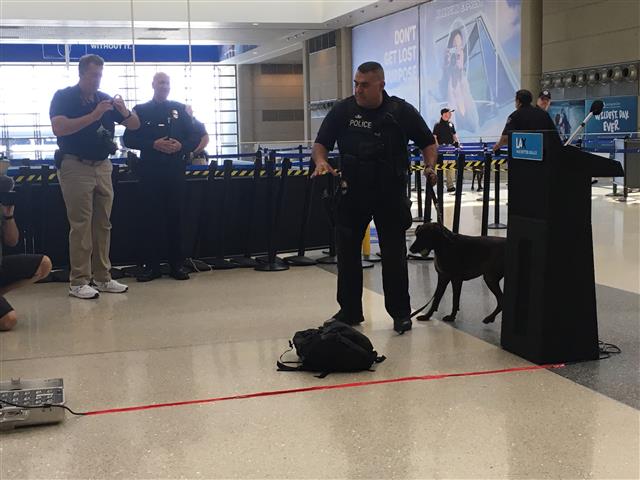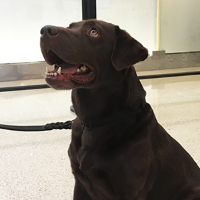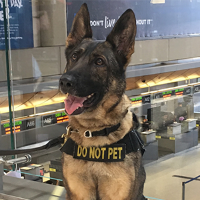LAX Celebrates K-9 Partners for 'Work Like a Dog Day'

For Immediate Release
Aug. 5, 2019
Contact:
Frederick Badlissi
(424) 646-5260

(Los Angeles, CA) Los Angeles International Airport (LAX) celebrated some of the hardest working noses in the business as part of national "Work Like A Dog Day," with demonstrations and a class photo featuring canines from Los Angeles Airport Police (APD), the Transportation Security Administration (TSA) and U.S. Customs and Border Protection (CBP). A total of nine dogs showed off their skills at Tom Bradley International Terminal, demonstrating various detection and training techniques with their handlers.
"Los Angeles International Airport is one of the most dynamic environments in the country, requiring an equally dynamic law-enforcement program with multiple specializations across a very diverse campus,” said David Maggard, Deputy Executive Director for Law Enforcement and Homeland Security, LAWA. "Our airport police canines and officers use special training and tactics to help identify potential threats from the curb to the gate, inspect international cargo and serve as a force multiplier to our public safety efforts.”
LAX has the largest aviation police force of any U.S. airport, and also deploys the largest explosive detection unit in the country, which includes a significant number of K-9 teams that are used across the airport. APD also has canines trained in suspect apprehension. TSA deploys its own explosive detection K-9 teams at LAX at the security screening checkpoints in a variety of capacities, including the agency's real-time threat assessment program, which enhances the efficiency of the security screening process. In 1984, LAX became the first airport to host CBP's famed "Beagle Brigade," which uses the pups to inspect international arrivals for prohibited agricultural items.
Together, these canines, which come in a variety of breeds and sizes, are protecting tens of millions of passengers each year by cooperating in a multi-layered approach to airport security.
“Passenger Screening Canines and their handlers play an important role in the efficiency of the security operations at LAX,” said Keith Jeffries, TSA Federal Security Director at LAX. “They not only have expert skills in detecting the presence of explosives, they are one of our most visible layers of security, and a passenger favorite as well.”
Both TSA and APD canines receive extensive and specialized training at Lackland Air Force Base in San Antonio, Texas. As part of a 12-week program, each dog is carefully screened and exposed to hundreds of explosive odors. Handlers learn about canine psychology in order to improve their interactions as they learn to read each dog's actions.
The TSA National Explosives Detection Canine Team Program has played an integral role in protecting the nation’s transportation systems since 1972, when the Federal Aviation Administration (FAA) first started the program. TSA assumed program responsibilities in 2002, and it remains a vital component of airport security programs across the country.
In 2011, TSA expanded the program by deploying Passenger Screening Canine (PSC) teams. These teams are composed of a Transportation Security Inspector and a canine trained to detect explosives carried or worn by a person. The teams now operate at airports across the country, including at LAX, working to detect explosive odors at checkpoints and in both the sterile and public areas of airports. PSC teams were part of today's demonstration, and can be found in all nine of LAX's terminals.
CBP at LAX utilizes beagles to defend the front line of the nation's agricultural health, using their keen sense of smell to detect foreign items and tainted goods. Should someone unwittingly attempt to import items like diseased fruit or other foods, CBP's canines can sniff them out from across a room. You'll find them working in CBP inspection areas located throughout LAX.
“The Beagle Brigade program at LAX is extremely effective in detecting foreign prohibited food items, invasive weed seeds and insects, and plant and animal diseases that pose a significant threat to U.S. agricultural industries and our nation’s economy,” said Donald R. Kusser, CBP Port Director of Los Angeles International Airport. “They are the preferred breed of dog at the airport because of their keen sense of smell, non-threatening size, high food drive and gentle disposition with the public.”
Video highlights from the event can be viewed here.



LAX, the sixth-busiest airport in the world serving nearly 66 million guests in 2022, is owned and operated by Los Angeles World Airports (LAWA), a proprietary, revenue-generating department of the City of Los Angeles that also governs Van Nuys Airport (VNY). As the international gateway to the Southern California region, LAX and its partners are dedicated to meeting global airport standards for customer satisfaction, safety, regional economic leadership, organizational performance and sustainability.
To better serve the millions of domestic and international guests that travel through LAX each year, the airport is undergoing a multi-billion-dollar capital improvement program to modernize its entire campus. Initiatives underway include an Automated People Mover, a Consolidated Rental Car Facility and two projects that will each add over one million square feet to the airport's existing property: Terminal 9 and Concourse 0. For more information about LAX, its transformation and its environmental, social and local workforce commitments, please visit flylax.com. Follow LAX on X (formally Twitter), Instagram, LinkedIn, Facebook and YouTube.
As a covered entity under Title II of the Americans with Disabilities Act, the City of Los Angeles does not discriminate on the basis of disability and, upon request, will provide reasonable accommodation to ensure equal access to its programs, services, and activities. Alternative formats in large print, braille, audio, and other forms (if possible) will be provided upon request.

